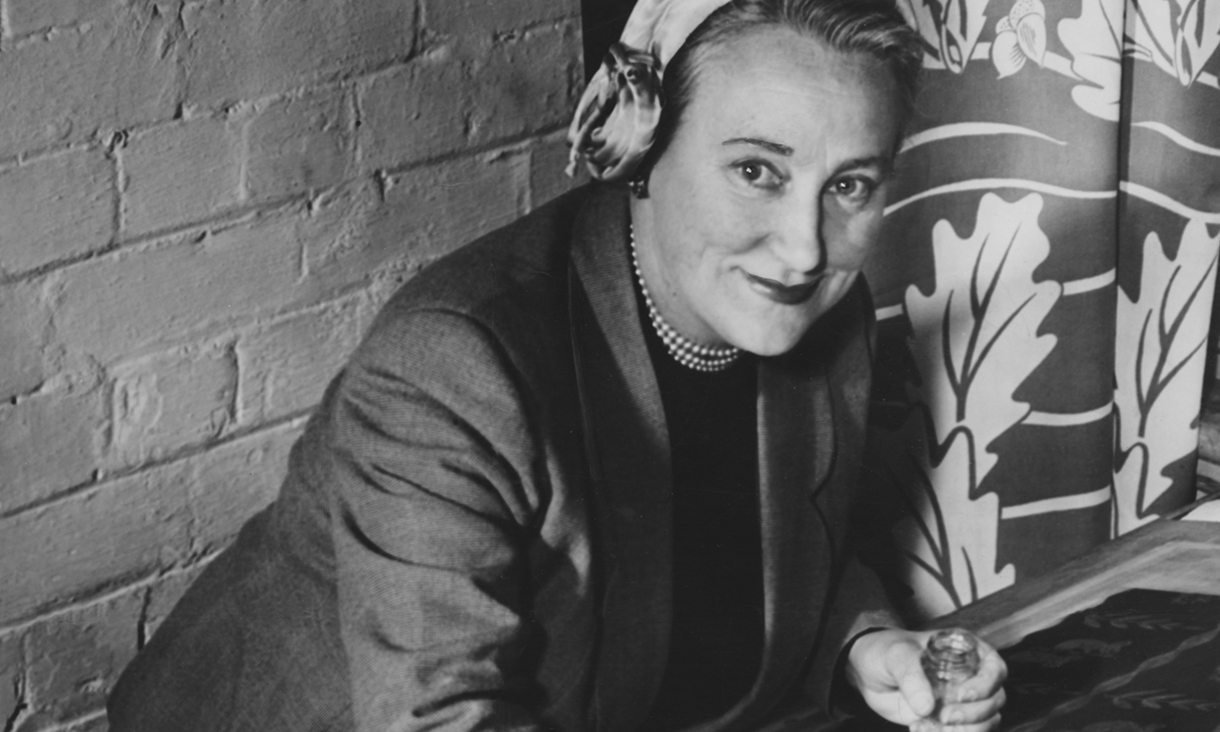Frances Burke: Designer of Modern Textiles released

Frances Burke: Designer of Modern Textiles is a rich presentation of the life and work of the iconic Australian designer. Image: Frances Burke c 1951, The Age, Fairfax.
In summary
• Frances Burke: Designer of Modern Textiles book has been released
• Textile designer Frances Burke was a visionary who understood the power of personal branding as early as 1948
• She is the focus of a monograph co-authored by adjunct scholar and researcher at Swinburne’s School of Design and Architecture, Nanette Carter
Frances Burke: Designer of Modern Textiles, a monograph presenting the life and work of Australia’s leading textile designer and promoter of modern design in the postwar era, Frances Burke, has been released.
Adjunct scholar and researcher at Swinburne’s School of Design and Architecture, Nanette Carter and independent scholar and founder of the Frances Burke Textile Resource Centre at RMIT, Robyn Oswald-Jacobs, collaborated to bring the book to life. Their research was a shared journey.

Robyn Oswald-Jacobs (left) and Nanette Carter’s research was a shared journey.
Frances was a forerunner
By all accounts, Frances was a dynamic and innovative character. She possessed bright blue eyes, a commanding voice and an entrepreneurial streak.
’Burke was the first Australian designer to receive an MBE in recognition of her contribution and influence,’ explains Carter. ‘She was the sole woman foundation member of the Society of Designers for Industry in 1948, the forerunner of today’s Design Institute of Australia, and a board member of the pioneering Museum of Modern Art and Design in Melbourne.’

The front cover of the monograph presenting the life and work of Australia’s leading textile designer.
Motifs and motivations
The book focuses on why and how Burke established her career as a designer; how she built a national market for her production; the creation of her personalised brand; her collaboration with leading Melbourne architects including Robin Boyd, Roy Grounds and Guilford Bell; her success in supplying clients during the postwar housing boom and a chapter on her final years when she moved from design practice and writing about design, to advocacy for design, art and craft.

Bird and Tree (1940) by Burke, Courtesy Ararat Gallery TAMA, Ararat Rural City Council and MDP Photography & Video, ©RMIT University.
Six sections of the book discuss the motifs Burke explored in her work, including abstract designs, marine themes and Indigenous-influenced designs.

Surf (1950), screenprint, 87 x 91cm, NGA, Canberra, Gift of Frances Burke, 1984, ©RMIT University.
An advocate for Australian design
Carter and Oswald-Jacobs conducted archival research at the State Library, National Library in Canberra, Mitchell Library in Sydney, University of Melbourne Archives and investigated various hospital and other institutional archives. They interviewed senior architects who recommended clients to Frances Burke in the 50s and 60s and spoke to clients who had purchased Burke’s fabrics or had grown up in homes where they were surrounded by them.

Caption - Angel Fish (1949) commissioned by architect Guilford Bell for the Hayman Island Resort. Courtesy Ararat Gallery TAMA, Ararat Rural City Council and MDP Photography & Video, ©RMIT University.
‘We discovered Burke’s career was more varied than we thought. As a result, we’ve built a complex, detailed picture of her role as an advocate for Australian design and her collaborations with leading architects of the period,’ says Carter.
Frances Burke: Designer of Modern Textiles is published by Melbourne University Publishing.
-
Media Enquiries
Related articles
-

- Design
Swinburne alum launches zine celebrating Asian Australian art and identity
Swinburne Graphic Design alum Dan Truong founded HOISZN, a zine publication showcasing Asian Australian artists and their work.
Monday 01 July 2024 -

- Design
Swinburne students shine in lighting design collaboration
Swinburne students collaborated with About Space Lighting, resulting in several student-designed lamps being put into production.
Friday 07 June 2024 -

- University
Swinburne University of Technology partners with Grande Experiences and THE LUME Melbourne for cutting-edge Immersive Media education
Swinburne University of Technology is proud to announce its partnership with Grande Experiences and THE LUME Melbourne, enhancing the future of Immersive Media education.
Thursday 13 June 2024 -

- Design
Yarra Trams feature Women in Trades campaign designed by Swinburne students
School of Design and Architecture students in Swinburne’s Bureau collaborated with Tradeswomen Australia Group to design a tram wrap celebrating women in trades.
Thursday 16 May 2024 -

- Design
- Astronomy
- Technology
- University
Swinburne ‘Rock Muncher’ takes part in Australian Rover Challenge
A multidisciplinary student team from Swinburne University of Technology competed in the 2024 Australian Rover Challenge held in Adelaide, South Australia.
Thursday 11 April 2024

